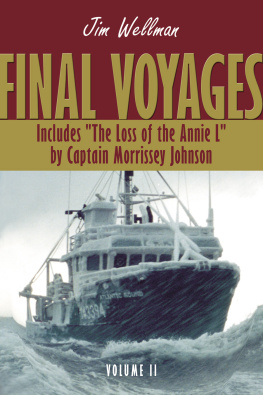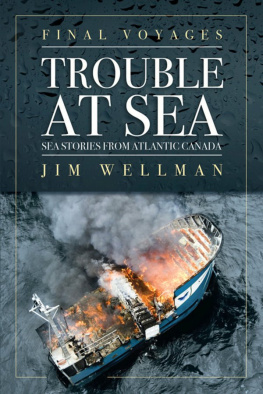The Sandman: His Ship Stories
by
William J. Hopkins
Yesterday's Classics
Chapel Hill, North Carolina
Cover and Arrangement 2010 Yesterday's Classics, LLC
All rights reserved. No part of this book may be reproduced or retransmitted in any form or by any means without the written permission of the publisher.
This edition, first published in 2010 by Yesterday's Classics, an imprint of Yesterday's Classics, LLC, is an unabridged republication of the work originally published by The Page Company in 1907. This title is available in a print edition (ISBN 978-1-59915-302-5).
Yesterday's Classics, LLC
PO Box 3418
Chapel Hill, NC 27515
Yesterday's Classics
Yesterday's Classics republishes classic books for children from the golden age of children's literature, the era from 1880 to 1920. Many of our titles are offered in high-quality paperback editions, with text cast in modern easy-to-read type for today's readers. The illustrations from the original volumes are included except in those few cases where the quality of the original images is too low to make their reproduction feasible. Unless specified otherwise, color illustrations in the original volumes are rendered in black and white in our print editions.
Contents
The Ship-Building Story
O NCE upon a time there was a wide river that ran into the ocean, and beside it was a little city. And in that city was a wharf where great ships came from far countries. And a narrow road led down a very steep hill to that wharf, and anybody that wanted to go to the wharf had to go down the steep hill on the narrow road, for there wasn't any other way.
And because ships had come there for a great many years, and all the sailors and all the captains and all the men who had business with the ships had to go on that narrow road, the flagstones that made the sidewalks were much worn. That was a great many years ago.
The river and the ocean are there yet, as they always have been and always will be; and the city is there, but it is a different kind of a city from what it used to be. And the wharf is slowly falling down, for it is not used now; and the narrow road down the steep hill is all grown up with weeds and grass.
A great many years ago, when the ships still came to that wharf, a man used to go down the narrow road very often, for, although he had no business with the ships that came there, he liked to look at them and to be near them. And at last he thought he would be a ship-builder; for he had studied the building of ships and he knew how.
So he looked all around for a place that would be good for ship-building. He had to have a place that was pretty level and pretty smooth, and it must be beside the water, and the water right next to it must be wide enough, so that the ships, when they were launched, would not go slam-bang into the show on the other side; and it must be deep enough, so that the ships would not stick in the mud at the bottom.
At last, when he had looked at a great many places, he found the right kind of a place for ship-building. It was a great meadow, all smooth and flat, beside a wide river. The men who had owned it had used it to cut salt hay from; for it was not very far from the great ocean, and the tide came up and went down there, and sometimes the meadow was all covered with water at high tide. So this man, who wanted to build ships, bought the meadow and paid the men money for it, and it was his.
Then he began to make it ready for building ships. There wasn't very much to do to it. First he built a blacksmith shop in one corner, near the road. And what the blacksmith shop was for is told about in the Blacksmith Story.
While the men were building the blacksmith shop, other men were building a shed on the other side of the meadow. A part of the shed was all open in front, with only posts there, to hold up the roof. The other part had a wall all around. The open part was to put logs in, so that they would dry enough, and for the men to work in when it rained. In the part with the wall all around was a furnace and a boiler. And from the boiler was a pipe that went out through the wall at the back and into a long wooden box. Then, when a fire was built in the furnace, the water in the boiler got hotter and hotter until it boiled and turned to steam; and the steam went through the pipe into the long wooden box. You will know, pretty soon, why they wanted steam in the long wooden box.
That was all there was to do to the meadow to make it a shipyard, and the master of the shipyard didn't do anything more to it until he began to build a ship. Then, one day, two men came to see the master. One was Captain Jonathan and the other was Captain Jacob.
"We have decided to have a vessel built for us," said Captain Jonathan. "It will be a brig, and we shall call it the Industry . We should like to have you build it."
The master was very glad to hear Captain Jonathan say that, and he said that he would build the brig Industry for them, and he would make it very strong and very safe, so that it could sail through any kind of a storm and not be hurt. So Captain Jonathan and Captain Jacob and the master agreed about the brig Industry , and Captain Jonathan and Captain Jacob went away.
Then the master of the shipyard sent for a lot of men who knew how to build ships. And some of them he sent away to find trees that were the right kind. He wanted all the trees to be live-oak, and some of them he wanted to be straight and some crooked. So the men went where those trees grew, and they picked out a great many live-oak trees. And some of the trees were straight and some were crooked; and the crooked ones were all kinds of shapes that were right to go in a ship. And they cut those trees down and they cut off the branches, so that the trees were nothing but logs. It was winter, but no snow was on the ground, for snow does not often fall where those trees grow.
Then the men went to work with a great many yoke of oxen, and they hauled those logs to the river that was nearest, and they loaded the logs into a vessel that was waiting there. They couldn't load them on railroad cars, for they did not have railroads then. And when the vessel was all loaded so that it couldn't take any more, the men got on and they sailed away out of the river and over the great ocean until they came to the wide river that the shipyard was beside. And they sailed up that river until they came to the shipyard, and they tied the ship with great ropes to a wharf that the other men had built while they were away getting the live-oak logs. And they took all the logs out of the vessel and put them on the ground, not in a pile, but each one by itself. And the logs, put that way, each by itself, nearly covered the ground, so that there was hardly room to walk about without walking on the logs.
Then the master of the shipyard came and looked at each log carefully, and decided where it would go the best in the ship, and he had the men pile the logs in the open shed in order. And three of the largest and straightest logs he picked out for the keel of the Industry . For the keel is the very bottomest part of a vessel, so that it has to be laid first of all; and it must be very strong, for all the ribs are fastened to it.
So the men took their broadaxes and their adzes and went to work upon the keel logs, making them square and smoothing them off. A broadaxe is like a common axe, but it has a broad blade; and an adze is like an axe turned a quarter way around, so that it cuts like a hoe when it is used for weeding, except that it is sharp and heavy. And the sound of the adzes and of the axes on the live-oak logs was a pleasant sound, and the master of the shipyard liked to hear it. And the men talked with each other while they worked.














